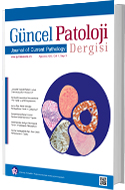2 Dr. Lütfi Kırdar Kartal Eğitim ve Araştırma Hastanesi, Genel Cerrahi Kliniği, İSTANBUL
DOI : 10.5146/jcpath.2017.13 Aim: The clinical utility of pathologic nipple discharge cytology is still controversial and obtained in only minor population of patients. Therefore, most pathologist do not evaluate a significant number of nipple discharge cytology in their routine practice. The objective of the current study is to compare the cytologic diagnosis of ?suggestive papillary lesions? with their histologic diagnosis and to evaluate cytologic criteria for the distinction of papillary and their distinctive lesions.
Materials and Methods: A retrospective analysis of nipple discharge cytology samples was performed between January 1, 2015 and December 31, 2016. Patients who underwent surgical excision after a nipple discharge cytology diagnosis of ?suggestive papillary lesions? were included the study. Cytologic slides were re-evaluated and graded for the morphologic features of three dimentional ductal groups.
Results: In the present study 25 patients (median age:46 years; range:26-81) with nipple discharge cytology were examined. Histopathologic findings showed 2 (8%) ductal carcinoma in situ, 6 (24%) intraductal papilloma, 2 (8%) atipical intraductal papilloma, 3 (12%) multiple intraductal papillomatosis, 1 (4%) nipple adenoma, 9 (36%) duct ectasia and 2 (8%) fibrocystic changes.
Conclusion: Three dimentional and papillary ductal groups were seen in both non-neoplastic and neoplastic breast lesions. The increasing number of groups and large, braching clusters had 50% and 57% sensitivity; and 55% and 64% specificity for neoplastic lesions, respectively.
Anahtar Kelimeler : Nipple discharge, Papillary breast lesions, Cytology

